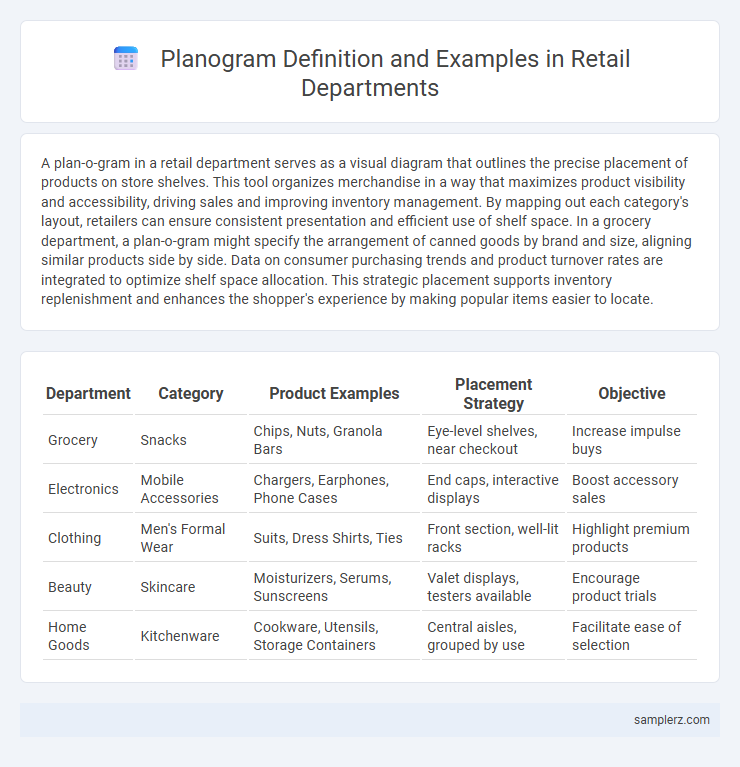A plan-o-gram in a retail department serves as a visual diagram that outlines the precise placement of products on store shelves. This tool organizes merchandise in a way that maximizes product visibility and accessibility, driving sales and improving inventory management. By mapping out each category's layout, retailers can ensure consistent presentation and efficient use of shelf space. In a grocery department, a plan-o-gram might specify the arrangement of canned goods by brand and size, aligning similar products side by side. Data on consumer purchasing trends and product turnover rates are integrated to optimize shelf space allocation. This strategic placement supports inventory replenishment and enhances the shopper's experience by making popular items easier to locate.
Table of Comparison
| Department | Category | Product Examples | Placement Strategy | Objective |
|---|---|---|---|---|
| Grocery | Snacks | Chips, Nuts, Granola Bars | Eye-level shelves, near checkout | Increase impulse buys |
| Electronics | Mobile Accessories | Chargers, Earphones, Phone Cases | End caps, interactive displays | Boost accessory sales |
| Clothing | Men's Formal Wear | Suits, Dress Shirts, Ties | Front section, well-lit racks | Highlight premium products |
| Beauty | Skincare | Moisturizers, Serums, Sunscreens | Valet displays, testers available | Encourage product trials |
| Home Goods | Kitchenware | Cookware, Utensils, Storage Containers | Central aisles, grouped by use | Facilitate ease of selection |
Introduction to Plan-o-Grams in Department Stores
Plan-o-grams in department stores strategically arrange products to maximize shelf space and enhance shopper experience. By grouping related items and optimizing product placement, retailers increase visibility and drive sales for key categories like cosmetics, apparel, and home goods. Effective plan-o-grams rely on data analytics and customer behavior insights to tailor displays that align with store layout and seasonal trends.
Importance of Plan-o-Grams in Retail Merchandising
Plan-o-grams in retail merchandising strategically arrange products within departments to maximize visibility and sales by guiding customer flow and optimizing shelf space. Effective plan-o-grams use data on consumer behavior and product performance to enhance brand prominence and ensure compliance with merchandising standards. This systematic approach drives inventory efficiency, reduces stockouts, and elevates the overall shopping experience, directly impacting retail profitability.
Key Elements of a Department Store Plan-o-Gram
A department store plan-o-gram strategically arranges merchandise to maximize visibility and sales by grouping related products in defined zones such as apparel, cosmetics, and home goods. Key elements include shelf height optimization, ensuring popular items are placed at eye level, and clear signage that directs customers through themed displays. Inventory turnover rates and seasonal trends guide the frequency of plan-o-gram updates, enhancing shopper experience and operational efficiency.
Step-by-Step Guide to Creating a Department Plan-o-Gram
Creating a department plan-o-gram involves analyzing product categories and sales data to optimize shelf space and improve product visibility. Start by categorizing items based on consumer demand, then use sales performance and inventory levels to allocate appropriate shelf space. Regularly review and adjust the layout according to seasonal trends and customer purchasing behavior to maximize sales efficiency.
Visual Example: Clothing Department Plan-o-Gram
A clothing department plan-o-gram strategically arranges apparel by category, color, and size to enhance visual appeal and ease of shopping. Mannequins display featured outfits near entrances to attract attention, while wall fixtures and shelving units highlight seasonal collections and best-sellers. Signage clearly marks sections like men's, women's, and accessories, optimizing customer flow and increasing sales opportunities.
Sample Plan-o-Gram for Beauty and Cosmetics Section
A sample plan-o-gram for the Beauty and Cosmetics section typically organizes products by category, such as skincare, makeup, and fragrances, to enhance shopper navigation and maximize shelf visibility. Brands like L'Oreal, Estee Lauder, and Clinique are strategically placed at eye level to boost sales, while promotional items and new launches occupy end caps and feature displays for increased customer engagement. Optimizing shelf space using product facings, size, and color coordination improves inventory management and drives higher turnover rates in high-traffic retail environments.
Electronics Department Plan-o-Gram Layout Example
The Electronics Department plan-o-gram layout strategically organizes products by category, featuring high-demand items like smartphones and laptops at eye level to maximize visibility and sales. Accessories such as chargers, headphones, and smart home devices are placed in adjacent sections to encourage cross-selling and enhance customer experience. Shelf labels and signage optimize navigation, guiding shoppers through organized zones that balance brand prominence and product variety efficiently.
Grocery Section Plan-o-Gram Illustration
The Grocery Section Plan-o-Gram illustrates precise shelf organization by categorizing products such as canned goods, cereals, and snacks to maximize visibility and accessibility. Items are strategically placed based on sales data and consumer behavior patterns, ensuring high-demand products occupy eye-level positions while promotional items are highlighted near checkout areas. This systematic layout improves inventory management, boosts sales, and enhances the overall shopping experience in retail grocery departments.
Best Practices for Implementing Plan-o-Grams in Departments
Effective plan-o-grams in retail departments optimize product placement by grouping complementary items and maximizing shelf visibility to boost sales. Prioritize high-demand products at eye level while using data analytics to adjust layouts based on customer behavior and inventory turnover. Consistent compliance checks and staff training ensure plan-o-grams maintain alignment with seasonal promotions and merchandising goals.
Measuring Success: Plan-o-Gram Compliance in Retail Departments
Retail departments use plan-o-grams to organize product displays based on strategic merchandising guidelines, optimizing shelf space and enhancing customer experience. Measuring plan-o-gram compliance involves tracking metrics such as product placement accuracy, shelf facings, and inventory levels through audits and technology-driven tools like plan-o-gram software. High compliance rates correlate with increased sales per square foot and improved inventory turnover, indicating successful execution of strategic merchandising plans.

example of plan-o-gram in department Infographic
 samplerz.com
samplerz.com